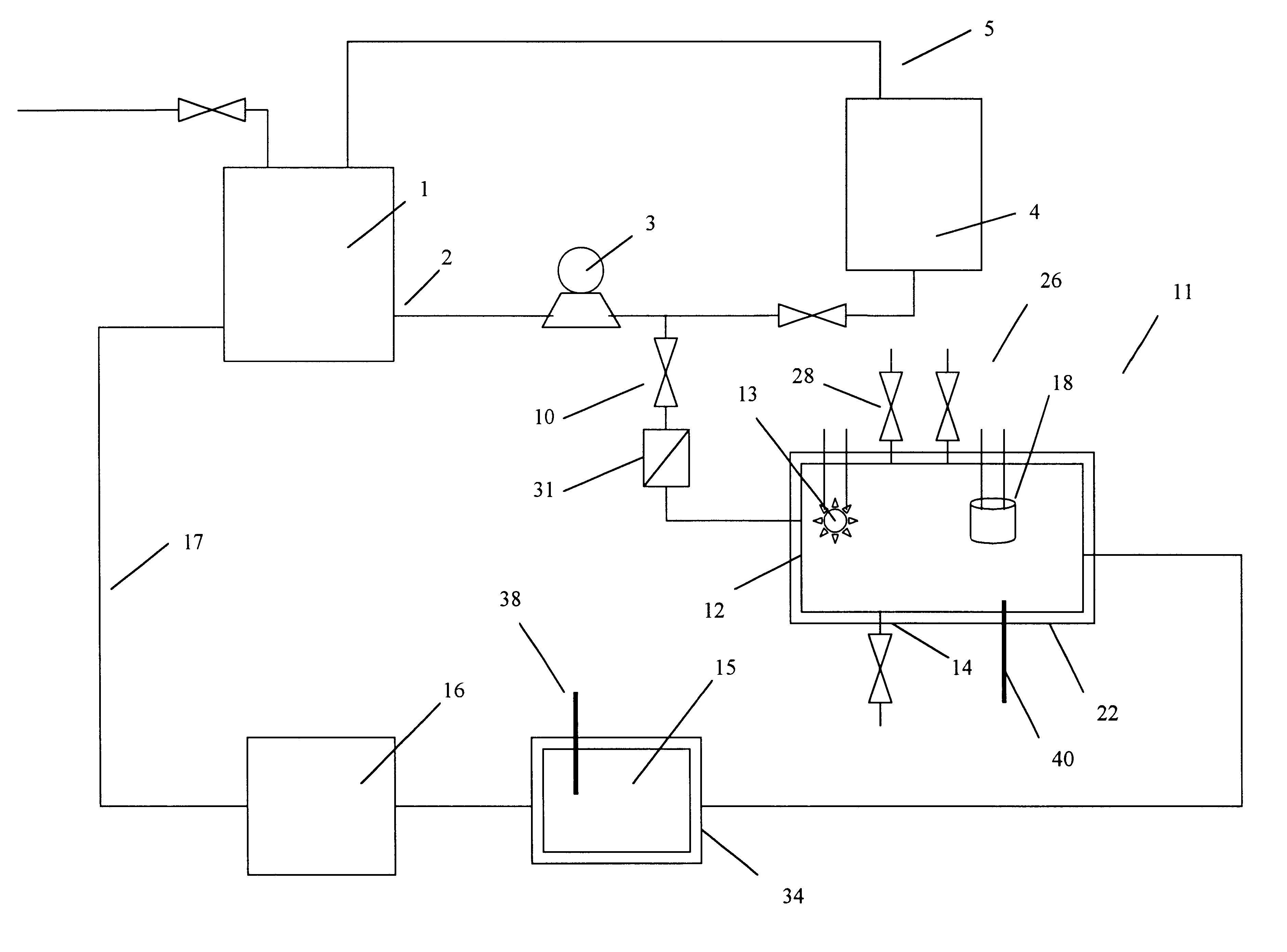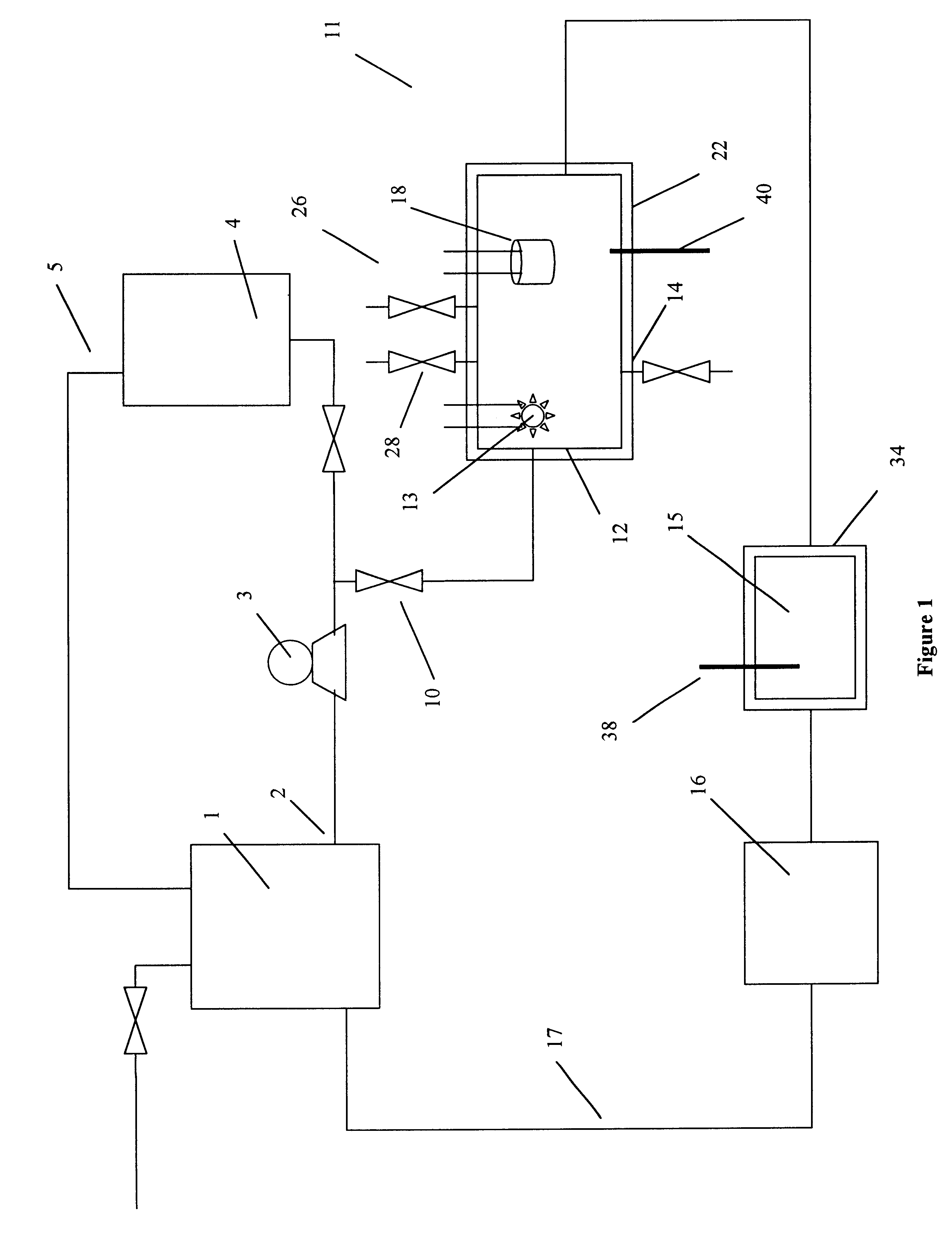Regeneration of plating baths
a technology of plating bath and oxidation system, which is applied in the direction of cell components, multi-stage water/sewage treatment, separation processes, etc., can solve the problems of iron having a deleterious effect on the performance of the plating process, and achieve the effect of reducing the level of organic contaminant, reducing the demand on the oxidation system, and maximizing the gas
- Summary
- Abstract
- Description
- Claims
- Application Information
AI Technical Summary
Benefits of technology
Problems solved by technology
Method used
Image
Examples
example 2
The removal of high concentrations of plating additives from a copper plating solution with ozone gas and hydrogen peroxide in the presence of copper ions by a reactor from the system shown in FIG. 1 is illustrated. The state of the oxidation process was monitored by a total organic carbon analyzer and an ozone gas monitor. A water cooled, jacketed, quartz tube which contained a 400 watt medium pressure mercury arc lamp from Sunlight Systems, Bogota, N.J. was placed in the center of a 3 liter glass reactor from ACE Glass, Vineland, N.J. Ozone gas was supplied to the solution in the reactor by ozone Generator AX8400 from Astex, Inc, Woburn, Mass. through a ceramic sparger. An ozone gas monitor from IN USA, of Needham, Mass. was connected to the reactor gas outlet, 26 and along with the total organic carbon analyzer served as an endpoint monitor for the state of the oxidation reaction.
Two liters of a solution containing approximately 125 grams per liter of copper sulfate at a pH of ab...
example 3
The removal of plating additives from a copper plating solution with ozone gas, hydrogen peroxide, and carbon filtration in the presence of copper ions by a reactor from the system shown in FIG. 1 is illustrated. The state of the oxidation process was monitored by a total organic carbon analyzer and an ozone gas monitor. A water cooled, jacketed, quartz tube which contained a 400 watt medium pressure mercury arc lamp from Sunlight Systems, Bogota, N.J. was placed in the center of a 3 liter glass reactor from ACE Glass, Vineland, N.J. Ozone gas was supplied to the solution in the reactor by ozone Generator AX8400 from Astex, Inc, Woburn, Mass. through a ceramic sparger. An ozone gas monitor from IN USA, of Needham, Mass. was connected to the reactor gas outlet. A carbon filter from KX Industries L.P., of Orange, Conn., was connected to the outlet of the reactor and oxidized solution pumped through the filter. The total organic carbon analyzer served as an endpoint monitor for the sta...
example 4
The removal of plating additives from a copper plating solution in an in-line, continuous process, with ozone gas, and carbon filtration in the presence of copper ions by a reactor from the system shown in FIG. 1 is illustrated. The state of the oxidation process was monitored by a total organic carbon analyzer. Two 3 liter Teflon.RTM. PFA containers served as reactors and were connected to each other in series. Each reactor contained a quartz tube in which a 400 watt medium pressure mercury arc lamp from Sunlight Systems, Bogota, N.J. was placed. The quartz tubes were cooled with a flow of nitrogen gas. Liquid was pumped through the reactors using a gear pump with Teflon.RTM. gears. Ozone gas was supplied to each reactor by ozone Generator AX8400 from Astex, Inc, Woburn, Mass. through a ceramic sparger in each reactor. An ozone gas monitor from IN USA, of Needham, Mass. was connected to the reactor gas outlets. A third 3 liter Teflon.RTM. PFA reactor container was connected to the ...
PUM
| Property | Measurement | Unit |
|---|---|---|
| Concentration | aaaaa | aaaaa |
| Energy | aaaaa | aaaaa |
| Level | aaaaa | aaaaa |
Abstract
Description
Claims
Application Information
 Login to View More
Login to View More - R&D
- Intellectual Property
- Life Sciences
- Materials
- Tech Scout
- Unparalleled Data Quality
- Higher Quality Content
- 60% Fewer Hallucinations
Browse by: Latest US Patents, China's latest patents, Technical Efficacy Thesaurus, Application Domain, Technology Topic, Popular Technical Reports.
© 2025 PatSnap. All rights reserved.Legal|Privacy policy|Modern Slavery Act Transparency Statement|Sitemap|About US| Contact US: help@patsnap.com



